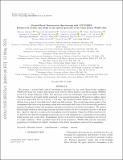Files in this item
Ground-based transmission spectroscopy with VLT FORS2 : evidence for faculae and clouds in the optical spectrum of the warm Saturn WASP-110b
Item metadata
| dc.contributor.author | Nikolov, Nikolay | |
| dc.contributor.author | Maciejewski, Gracjan | |
| dc.contributor.author | Constantinou, Savvas | |
| dc.contributor.author | Madhusudhan, Nikku | |
| dc.contributor.author | Fortney, Jonathan J. | |
| dc.contributor.author | Smalley, Barry | |
| dc.contributor.author | Carter, Aarynn L. | |
| dc.contributor.author | de Mooij, Ernst J.W. | |
| dc.contributor.author | Drummond, Benjamin | |
| dc.contributor.author | Gibson, Neale P. | |
| dc.contributor.author | Helling, Christiane | |
| dc.contributor.author | Mayne, Nathan | |
| dc.contributor.author | Mikal-Evans, Thomas | |
| dc.contributor.author | Sing, David K. | |
| dc.contributor.author | Wilson, Jamie | |
| dc.date.accessioned | 2022-08-02T23:43:55Z | |
| dc.date.available | 2022-08-02T23:43:55Z | |
| dc.date.issued | 2021-09-01 | |
| dc.identifier | 275602445 | |
| dc.identifier | d986da48-31fe-4b61-8de2-7caa701e65fa | |
| dc.identifier | 85112366850 | |
| dc.identifier | 000680667400001 | |
| dc.identifier.citation | Nikolov , N , Maciejewski , G , Constantinou , S , Madhusudhan , N , Fortney , J J , Smalley , B , Carter , A L , de Mooij , E J W , Drummond , B , Gibson , N P , Helling , C , Mayne , N , Mikal-Evans , T , Sing , D K & Wilson , J 2021 , ' Ground-based transmission spectroscopy with VLT FORS2 : evidence for faculae and clouds in the optical spectrum of the warm Saturn WASP-110b ' , Astronomical Journal , vol. 162 , no. 3 , 88 . https://doi.org/10.3847/1538-3881/ac01da | en |
| dc.identifier.issn | 0004-6256 | |
| dc.identifier.other | RIS: urn:5B715929005BD63066DC9AF14017EC14 | |
| dc.identifier.uri | https://hdl.handle.net/10023/25764 | |
| dc.description | G.M. acknowledges the financial support from the National Science Centre, Poland through grant No. 2016/23/B/ST9/00579. N.M. acknowledges funding from the UKRI Future Leaders Scheme (MR/T040866/1), Science and Technology Facilities Council Consolidated Grant (ST/R000395/1), and Leverhulme Trust research project grant (RPG-2020-82). | en |
| dc.description.abstract | We present a ground-based optical transmission spectrum for the warm Saturn-mass exoplanet WASP-110b from two transit observations made with the FOcal Reducer and Spectrograph on the Very Large Telescope. The spectrum covers the wavelength range from 4000-8333 Å, which is binned in 46 transit depths measured to an averaged precision of 220 parts per million (ppm) over an averaged 80 Å bin for a Vmag = 12.8 star. The measured transit depths are unaffected by a dilution from a close A-type field dwarf, which was fully resolved. The overall main characteristic of the transmission spectrum is an increasing radius with wavelength and a lack of the theoretically predicted pressure-broadened sodium and potassium absorption features for a cloud-free atmosphere. We analyze archival high-resolution optical spectroscopy and find evidence for low to moderate activity of the host star, which we take into account in the atmospheric retrieval analysis. Using the AURA retrieval code, we find that the observed transmission spectrum can be best explained by a combination of unocculted stellar faculae and a cloud deck. Transmission spectra of cloud-free and hazy atmospheres are rejected at a high confidence. With a possible cloud deck at its terminator, WASP-110b joins the increasing population of irradiated hot-Jupiter exoplanets with cloudy atmospheres observed in transmission. | |
| dc.format.extent | 16 | |
| dc.format.extent | 31830211 | |
| dc.language.iso | eng | |
| dc.relation.ispartof | Astronomical Journal | en |
| dc.subject | Exoplanet atmospheres | en |
| dc.subject | QB Astronomy | en |
| dc.subject | QC Physics | en |
| dc.subject | NDAS | en |
| dc.subject.lcc | QB | en |
| dc.subject.lcc | QC | en |
| dc.title | Ground-based transmission spectroscopy with VLT FORS2 : evidence for faculae and clouds in the optical spectrum of the warm Saturn WASP-110b | en |
| dc.type | Journal article | en |
| dc.contributor.institution | University of St Andrews. St Andrews Centre for Exoplanet Science | en |
| dc.contributor.institution | University of St Andrews. School of Physics and Astronomy | en |
| dc.identifier.doi | 10.3847/1538-3881/ac01da | |
| dc.description.status | Peer reviewed | en |
| dc.identifier.url | https://arxiv.org/abs/2105.06522 | en |
This item appears in the following Collection(s)
Items in the St Andrews Research Repository are protected by copyright, with all rights reserved, unless otherwise indicated.

